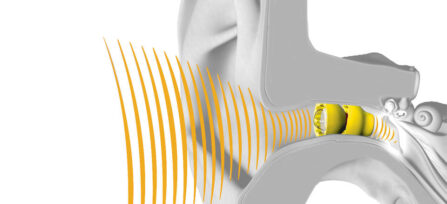What are Hearing Aid Channels and Bands?
When you buy a TV, one of the key specs you'll probably look for is the resolution.
When you buy a smartphone, you might want to look at battery capacity.
Specifications like these are helpful to ensure you're buying the right device for your needs.
When researching hearing aids, you may come across the terms “channels” and “bands,” and assume that these are important specs to consider.
Some hearing providers may even encourage you to focus singularly on these specs, as the hearing aids they offer may have more channels and bands then hearing aids offered by other hearing providers.
However, selecting a hearing based on the number of channels and bands it has is a mistake, and an oversimplified way of choosing a hearing aid.
In this post, we’ll explain these terms, the differences between them, and what research says about how many you need.
What Are Channels and Bands?
You may see these terms used interchangeably, but they technically refer to two different things.
Before we proceed, let's make sure you have a clear understanding of the difference between channels and bands.
Hearing Aid Channels
Sounds that you hear in everyday life are made up of different frequencies of sound ranging from bass tones (low tones) to treble tones (high tones).
When you get a hearing test, what's being tested, is your ability to hear at these varying frequencies, typically between 250 and 8000Hz.
Most people don’t hear exactly the same at each frequency. In fact, much of the time, hearing loss is worse in the high frequencies.
Therefore, in order to help restore your hearing, hearing aids need to amplify sounds more in some frequencies than others.
When a hearing aid microphone picks up sound, the sound signal is sent to a digital processing chip inside the hearing aid.
The chip splits the frequency range up into different channels.
For example, a four-channel hearing aid might have one channel for processing sounds in the 100-750 Hz range, one for 750-1500 Hz, one for 1500-3000 Hz, and one for 3000-6000 Hz.
The image below helps illustrate how hearing aid channels split up the task of processing sounds.

In short, having multiple channels allows the hearing aid to apply different amounts of amplification, and different sound processing strategies, to each of the channels.
One final note about hearing aid channels, before we move onto bands- don't confuse hearing aid channels, with hearing aid programs, as many people do. Programs are an entirely different concept.
Hearing Aid Bands
Hearing aid bands, refer to the frequency ranges that a hearing provider can adjust in the software while programming the hearing aid.
In our four channel hearing aid example above, the hearing provider might only be able to adjust two hearing aid bands in the software.
In the example below, the little square boxes represent hearing aid bands, which can be adjusted up or down by the hearing provider, to provide more or less amplification to a particular channel.

As a general rule, the more bands that are available to the hearing provider in the software, the more flexibility the hearing provider has to adjust the hearing aids to meet your amplification requirements appropriately.
For example, if when fitted with your hearing aids, you were to notice that things sounded tinny, or sharp, your hearing provider might grab the bands at 2000Hz, 4000Hz, and 8000Hz, and move them lower, to reduce amplification of those high frequencies.
However, that may then reduce amplification so much that words lose their clarity.
The hearing provider may then want to adjust bands more granularly, and adjust the band at 4000Hz in isolation, increasing the amplification for example, (without affecting the other channels).
Having more bands allows the hearing provider to do this.
Caution
When reading brochures from different hearing aid manufacturers, use of the terms “bands” and “channels” is not always followed consistently. You’ll see terms like “gain handles” and “fine tuning channels” used by manufacturers instead of “bands”.
The Difference Between Channels and Bands
It may seem like “channels” and “bands” are basically the same thing, but they aren’t quite the same.
Often hearing aids may have more channels than bands.
For example, a hearing aid may have 17 channels but only 10 gain bands in the software.
The reason for this is that the channels created by the digital chip in hearing aids are used for more than just amplification.
Hearing aids have many signal processing algorithms, such as noise reduction and feedback cancellation, that operate in the different channels.
Having multiple channels means that, for example, a noise reduction system can operate differently on one set of frequencies than the other.
This allows for much more sophisticated sound processing in hearing aids to try to reduce the effects of background noise and feedback without impacting speech intelligibility.
When a hearing provider adjusts bands in the software, he or she only adjusts the gain (amplification) of the hearing aids.
Those adjustments don’t directly impact other processes going on in the channels like noise reduction or feedback cancellation.
Perhaps an easy distinction between channels and bands is to think of channels as working automatically “behind the scenes”, while bands are one of the key tools your hearing provider will manually use to program your hearing aids.
What is the Optimal Number of Bands?
It depends on the hearing loss.
For someone who hears about the same across different frequencies, four bands may be enough to fit a hearing aid well to the hearing loss.
However, if you have much worse hearing in the high frequencies than the low frequencies, having more bands allows for more precise fitting of the hearing aids.
In my experience, six or seven bands is sufficient.
More bands than six or seven has the potential to be counterproductive, in my experience. The hearing aid’s response across different frequencies should change gradually. If there are too many rapid changes in gain between frequencies, the sound quality becomes harsh.
What is the Optimal Number of Channels?
Again, it depends on the hearing loss.
Some research has indicated that three channels may be enough for a flat loss, while as many as 18 may be helpful for some people with high-frequency hearing loss.
However, there isn’t a straightforward answer.
It depends on what question you’re asking.
Let’s start with this question: Do more channels make it easier to understand speech?
When you have multiple channels in a hearing aid, the compression system is operating differently in each of the channels.
Compression is the function of a hearing aid where soft sounds are amplified more than loud sounds.
So, in a multiple-channel hearing aid, soft speech sounds like “s” should be amplified more than louder vowels.
Having compression working in different channels often improves speech audibility.
At the same time, compression can make it more difficult to understand speech, especially for people with severe to profound hearing losses.
Some people may find that having more compression channels actually makes it harder to understand speech, because of distortion.
A different question would be to ask: Do more channels make the noise reduction system in the hearing aid work better?
Or, you could ask: Do more channels make the feedback management system work better?
These are hard questions to answer in hearing aid research, because there are so many variables at play and different hearing aid designs across manufacturers.
You should be wary of hearing aids that are advertised primarily on the basis of channels.
For example, one hearing aid on the market claims to have 96 channels.
Based on what we’ve discussed above, you should be skeptical of the claim that the hearing aid with 96 channels will outperform other hearing aids.
Conclusion
Having multiple bands in hearing aids makes it easier to adjust hearing aids to your hearing loss.
Multiple channels in hearing aids allow for more sophisticated compression, noise reduction, and feedback suppression algorithms.
However, a hearing aid that has a larger number of bands or channels may not necessarily perform better for you than a hearing aid that has a smaller number of bands or channels.
It’s important to take into account the entire picture of your hearing loss and the various technologies offered in the hearing aid when making your decision.
Your hearing provider will be able to assist you in selecting the hearing aids with the optimum number of channels and bands for your needs.







Fred Ganz
Jeff, Thank you for the information you explained above. It’s the first time I have read an explanation of what to expect in a hearing aid. I was checking into the Phonak brand only i don’t have $4000. & up to spend. I am looking into the Jabra 200 from Costco as there under $2000.00 I have an audio sound background (the reason for my loss of hearing) and clarity is a must. I don’t drive a Porch fut a Honda Fit. What is your take on Jabra hearing aids. Thank you for your time, Fred Ganz
Jeff, Thank you for the information you explained above. It’s the first time I have read an explanation of what to expect in a hearing aid. I was checking into the Phonak brand only i don’t have $4000. & up to spend. I am looking into the Jabra 200 from Costco as there under $2000.00 I have an audio sound background (the reason for my loss of hearing) and clarity is a must. I don’t drive a Porch fut a Honda Fit. What is your take on Jabra hearing aids. Thank you for your time, Fred Ganz
Jeff Hall
Hey honestly I’m not versed on that product. I’d recommend checking out Youtube reviews on it, and asking your question in the comments there, that’s probably gonna get you the best responses.
Hey honestly I’m not versed on that product. I’d recommend checking out Youtube reviews on it, and asking your question in the comments there, that’s probably gonna get you the best responses.